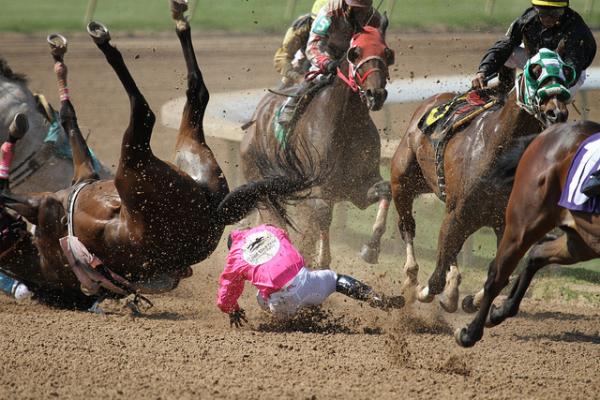Before the eye-rolling begins – "Oh no, not another concussion article" – let's remember that jockeys, who are largely overlooked if not relatively invisible in the sporting world, are people, too.
Since, as a group, these professionals are physically vulnerable and have few workplace protections, it seems reasonable to ask whether progress in concussion prevention is also taking place at the track.
The National Hockey League, the National Football League and even kids' football programs across the country are all currently seeking ways to prevent or minimize brain injuries. So given that these athletes race thunderously in tight packs at 30 miles an hour on 1,000-pound thoroughbreds, why shouldn't similar attention be paid to horse racing?
That question has been answered, and now that's happening.
The University of Kentucky (UK) College of Health Sciences, in conjunction with two established, national horse racing associations, is leading an effort to expand an existing health database for jockeys by collecting and adding concussion-related information. At the same time, it's developing a treatment protocol that can be applied if a jockey absorbs a head blow or is suspected to have suffered a concussion. Other sports have developed (or are developing) protocols to improve the safety of their athletes, and in that same vein, UK, in its second year in this particular saddle, is following suit.
"Our job is to protect jockeys by making sure that they operate in a safe racing environment," said Terry Meyocks, the National Manager of the Jockey's Guild, which has focused on the welfare of jockeys since 1940. "As the issue of concussions has come to the forefront, we've made it a priority to educate our jockeys and find ways to protect them, which is in everybody's best interest," he added, as quoted by the UK communications department.
Another reason this testing is essential is because in the culture of horse racing, jockeys will push themselves to compete even if they are not fully healthy because unlike most athletes, they do not hold sign contracts and are only paid per race. So if a jockey was thrown from his mount, he would have ample incentive to disguise any resulting cognitive deficiency, like blurred vision or memory loss, and – literally – get back on the horse.
The Jockey Club, founded 123 years ago and whose primary responsibility is billed as "the improvement of Thoroughbred breeding and racing," is also involved in the partnership to develop the concussion protocol.
To do so, researchers have to start at the beginning.
According to UK's Carl Mattacola, Ph.D, the only data previously collected on jockeys involved their medical histories, which was made accessible to trackside doctors in the event of injury. So the idea here was to conduct baseline cognitive testing for every jockey, with the results being added to the database and used if a head injury occurred.
For baseline testing, jockeys are interviewed about their injury history, and their cognition is tested by answering a series of questions. They then also perform a range of physical tasks that gauge neuromuscular performance and range of balance.
In the short term, this would only involve jockeys who compete in Kentucky, because currently, relevant healthcare guidelines vary state by state – or even track by track. The long-term goal, says Mattacola, is to create a protocol template in Kentucky that can eventually be adopted by other states.
For a sport where the spotlight has traditionally been trained more on the horse than its pilot, it's encouraging to see the intrepid jockey receiving important medical support to help protect his exciting yet perilous livelihood.




